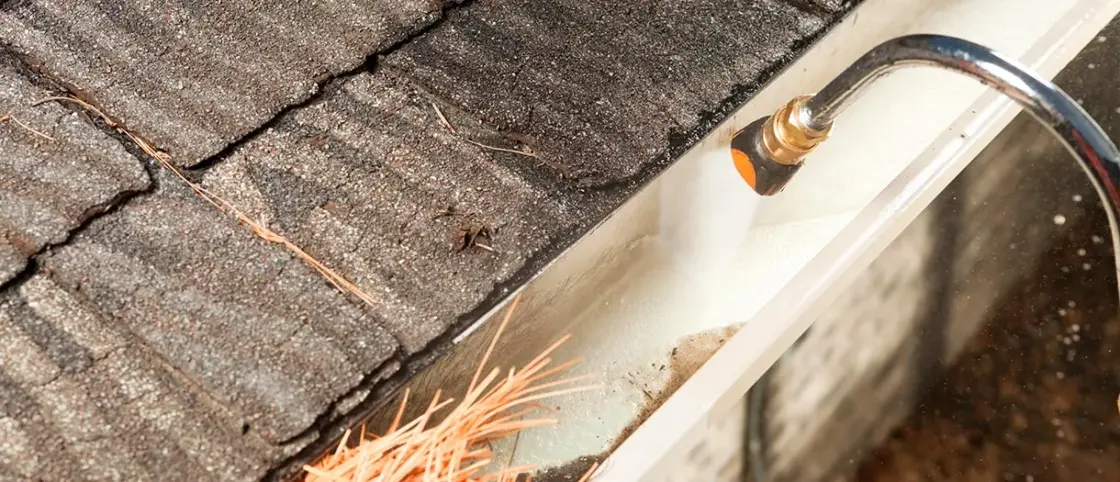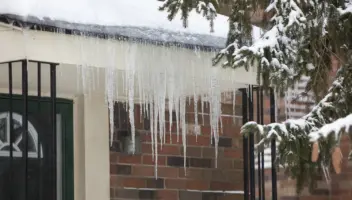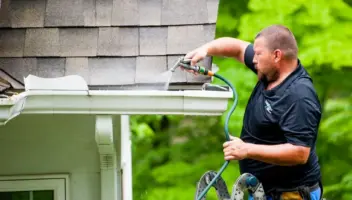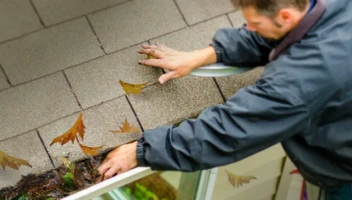How to Clean Gutters from the Ground (Without a Ladder)

Cleaning out gutters is a dirty but essential part of any home maintenance routine. Gutters protect your home from water damage by diverting water away from your house.
If your gutters are clogged, they won’t work properly, which can lead to serious damage to your home.
Learning how to clean gutters from the ground without using a ladder not only keeps you safe, but it also ensures your gutters are properly functioning.
Unfortunately, ladder falls are common and make gutter cleaning a dangerous task. In fact, thousands of people are injured annually from ladder falls. Every year, 500,000 people are treated for ladder-related injuries.
So the safest way to clean out your gutters is to clean them from the ground, without using a ladder. Read on to discover how to safely clean out your gutters from the ground using proven methods and helpful gutter cleaning tools.
In This Article:
- Why It’s Important to Clean Out Gutters
- Best Methods to Clean Gutters from the Ground
- How to Stop Gutters from Clogging
- Frequently Asked Questions
Why It’s Important to Clean Out Your Gutters

Photo by Connor Martin from Pexels
Gutters play a vital role in protecting your home from water damage. If you have clogged gutters, water can leak into your windows or the basement of your home. This sitting water can quickly cause damage.
When your gutters do get clogged with leaves, twigs or other debris, water will spill over the top and down the side of your home. These spills can damage your home’s roof, siding and foundation.
When allowed to build up over time, leaves decay, other debris becomes wet and begins to rot, and mold develops. This wet, rotting environment is especially attractive to various types of pests like wasps, roaches, ants, and rodents. Plus, gutters that aren’t draining properly may fill with standing water, creating an ideal breeding ground for mosquitoes.
Additionally, in the winter, melting snow and freezing rain can cause ice dams to form in clogged gutters. Ice dams can pull your gutters away from the roof, and even pose a danger to people walking below. That’s why we recommend that homeowners should clean out their gutters at least twice a year.
To avoid these types of issues, gutter guards are the ideal solution. They block debris, preventing clogs from occurring inside your home’s gutters, and—depending on the type of gutter guards—require minimal maintenance to work properly.
The 5 Best Methods to Clean Out Your Gutters from the Ground
Cleaning out your gutters from a ladder can be dangerous. So cleaning out your gutters from the ground is a much safer option.
Granted, it may take a little longer to clean them out than using a ladder, since it can be difficult to directly see the top or inside of the gutter system. But overall, it’s easier and safer to clean out your gutters from the ground.
Here are the best methods to clean out your gutters from the ground, so you don’t have to use a ladder and take unnecessary risks.
1. Leaf Blower Method

Photo by Chaiyawat Sri-Napom from Shutterstock
Using a leaf blower is an effective way to clean out your gutters from the ground. You can purchase an attachment for your leaf blower, which allows you to clean out your gutters without climbing up a ladder.
The attachment is a long pipe with a curved end to fit inside the gutter. This allows you to blow debris from inside the gutter out to the ground below.
Pros: Using a leaf blower is best for heavily clogged gutters filled with debris such as packed leaves, dirt, and twigs. Make sure you have a rake handy to clean up your lawn afterwards.
Cons: A leaf blower can potentially damage your gutters if too much force is applied, and they’re not always as effective at removing wet, compacted debris that adheres to the gutter walls.
Leaf Blower Gutter Cleaning Steps:
- Safety First: Wear safety goggles and a dust mask to protect your eyes and lungs from debris.
- Assemble Equipment: Attach a gutter cleaning kit to your leaf blower. These kits typically have elongated, curved nozzles to direct the air flow into the gutters.
- Check the Area: Make sure the ground around your house is clear and stable for you to walk on. Avoid working on uneven surfaces to prevent accidents.
- Position the Leaf Blower: Stand at one end of the gutter. Hold the leaf blower so the nozzle points into the gutter.
- Start Blowing: Turn on the leaf blower. Move the nozzle along the gutter, blowing out leaves, twigs, and debris. Work your way down the gutter, repositioning yourself as necessary.
- Clear Downspouts: Point the nozzle down the downspouts to clear any blockages. You may need to do this from both the top and bottom of the downspout, as well as any downspout extensions.
- Inspect and Repeat: After finishing one section of gutter, move to the next section and repeat the process. Ensure all sections are cleared of debris.
- Clean Up: Once you’ve finished, clean up any debris that has been blown onto the ground to keep your yard tidy.
2. Wet/Dry Vacuum Method

Photo by Charles Mann from Shutterstock
A wet/dry vacuum extension allows you to vacuum out your rain gutters from the ground. Most online retailers and hardware stores carry wet/dry vacuum kits. You may even be able to rent one.
Pros: The powerful suction allows you to remove most leaves, dirt, other debris, and standing water quickly. In some cases, the long hose allows you to reach second story roofs from the ground.
Cons: Wet/dry vacuums can be heavy and unwieldy to maneuver on a ladder when cleaning out overhead gutters. Heavier debris like twigs, wet leaves may clog the vacuum hose and attachment.
Wet/Dry Vac Gutter Cleaning Steps:
- Practice Safety: Wear protective gear such as gloves, safety goggles, and a dust mask.
- Prepare the Vacuum: Attach a gutter cleaning kit to your wet/dry vacuum. These kits usually include elongated hoses and curved attachments to reach the gutters.
- Secure the Area: Ensure the ground around your home is stable and clear of obstacles. Position your vacuum on a flat, secure surface.
- Start at One End: Position yourself at one end of the gutter. Hold the vacuum hose so the attachment reaches into the gutter.
- Begin Vacuuming: Turn on the vacuum and start removing debris from the gutters. Move the hose along the gutter, ensuring all leaves, twigs, and sludge are suctioned up.
- Clear Downspouts: Use the vacuum to clear the downspouts. If possible, vacuum both from the top and bottom of the downspout to ensure they’re thoroughly cleaned out.
- Inspect and Move Along: After completing one section of the gutter, proceed to the next section, repeating the cleaning process.
- Dispose of Debris: Properly dispose of the debris collected in the vacuum’s tank.
- Final Check: Once all sections are cleaned, do a final inspection to ensure no debris is left in the gutters or downspouts.
3. Garden Hose Method

Photo by Mike Bird from Pexels
A standard garden hose is another great option for cleaning out your gutters from the ground. Garden hose attachments–with a curved end–are widely available at your local hardware store.
Pros: Garden hoses are convenient and readily available for most homeowners, and the water pressure flushes out leaves and debris effectively.
Cons: They’re not as effective on tightly packed debris that resists flushing. Hoses also don’t fully remove all debris, and the excessive water can leak into fascia and soffits, which can eventually cause rot.
Garden Hose Gutter Cleaning Steps:
- Safety First: Wear protective clothing, including gloves and safety glasses, to protect yourself from falling debris and splashes.
- Prepare the Hose: Attach a gutter cleaning nozzle to your garden hose. These nozzles are designed to increase water pressure and are often angled for better reach.
- Extend the Pole: Attach the hose with the gutter cleaning nozzle to a telescopic extension pole. Adjust the pole to a length that comfortably reaches your gutters from the ground.
- Secure the Area: Ensure the area around your home is clear and that you have stable, flat ground to stand on.
- Begin at One End: Start at one end of the gutter. Position the pole so the nozzle is inside the gutter.
- Turn on Water: Turn on the hose and begin spraying the inside of the gutter. The water pressure should dislodge leaves, twigs, and other debris.
- Progress Along the Gutter: Slowly move along the gutter, repositioning yourself as needed. Use the water stream to push the debris towards the downspout.
- Clear Downspouts: Direct the water flow down the downspouts to clear any blockages. You may need to adjust the pole’s length or angle for better reach.
- Inspect and Repeat: After finishing one section, move to the next and repeat the process until all gutters are cleaned out.
- Clean Up: After you’re done, clean up any debris that has been washed onto the ground or around the downspouts.
This method is particularly effective for dislodging and flushing out loose debris. However, it might not be as effective for heavily compacted leaves or sludge, and it can be messy with water and debris potentially splattering.
4. Pressure Washer Method

Photo by Virrage Images from Shutterstock
For heavy-duty gutter cleaning, turn to a pressure washer. The extension wand allows you to blast away caked-on dirt and debris.
Pros: This method is perfect for gutters that haven’t been cleaned out in a long time. It quickly and efficiently removes packed dirt and leaves and clears clogged downspouts.
Cons: Using a pressure washer can get messy, so wear work clothes and plan to hose down your siding afterwards.
Pressure Washer Gutter Cleaning Steps:
- Safety Precautions: Wear protective gear like safety glasses, gloves, and ear protection. The high pressure can cause debris to fly unpredictably.
- Prepare the Pressure Washer: Attach a gutter cleaning attachment to your pressure washer. These attachments typically have angled nozzles and extenders to reach the gutters from the ground.
- Check Surroundings: Ensure the area is clear and stable. Position the pressure washer on a flat surface.
- Start at One End: Begin at one end of the gutter. Hold the pressure washer so the attachment reaches into the gutter.
- Activate the Pressure Washer: Turn on the pressure washer. Use a moderate pressure setting to start, as too high pressure can damage gutters.
- Clean the Gutters: Move the nozzle along the gutter, dislodging and washing away leaves, twigs, and debris. Be cautious with the pressure and angle to avoid damaging your roof or siding.
- Clear Downspouts: Direct the nozzle into the downspouts to clear blockages. You may need to adjust the angle or position for effective cleaning.
- Inspect and Move Along: After cleaning one section, move to the next, ensuring all debris is removed.
- Manage Debris: After cleaning, there will likely be debris and dirty water on the ground. Clean this up to prevent staining and slipping hazards and keep your lawn looking polished. .
- Final Check: Do a final inspection to ensure all sections are cleaned out and the gutters are intact.
5. Gutter Sense Tool Method

Photo by Suzanne Tucker from Shutterstock
The Gutter Sense gutter cleaning tool was designed to make cleaning out your gutters from the ground a reality. The Gutter Sense gutter cleaning tool features tongs that are intended to run flat into the gutters even if the extension pole is canted.
Pros: It can be attached to an extension pole and has been advertised to reach a two-story gutter and grasp onto all types of debris including pine needles.
Cons: It’s made of plastic and can break easily if not handled properly. It works best on K-style gutters with flat bottoms and may not work with other types of gutters.
Garden Sense Cleaning Tool Steps:
- Assemble the Tool: Attach the Gutter Sense cleaning tool to a telescopic extension pole. Ensure it’s securely fastened and the length is adjusted to comfortably reach your gutters.
- Safety Measures: Wear protective gear like gloves and safety glasses to protect against falling debris.
- Survey the Area: Make sure the area around your home is clear, and you have a stable, flat surface to stand on.
- Position the Tool: Stand at one end of the gutter. Position the Gutter Sense tool so that the tongs are facing the gutter.
- Operate the Tool: Pull the rope or handle attached to the tool to close the tongs. This action allows the tongs to grasp leaves, twigs, and debris in the gutter.
- Clean the Gutters: Carefully maneuver the tool along the gutter, opening and closing the tongs to grab and remove debris. It may require several passes to fully clean out each section.
- Dispose of Debris: After removing debris from a section, lower the tool and dispose of the collected debris into a garbage bag or bin.
- Move to the Next Section: Reposition yourself and the tool to clean the next section of gutter. Continue this process until all sections are cleared.
- Check Downspouts: Ensure downspouts are not clogged. If they are, you may need to clear them separately, possibly using a different method as the Gutter Sense tool is mainly for gutter troughs.
- Final Inspection: Once all sections are cleaned out, perform a final inspection to ensure no debris is left.
When to Hire a Professional

When it comes to cleaning out your gutters from the ground it’s always better, more efficient and safer to hire a professional gutter cleaning service. Professional gutter cleaning companies have the proper equipment and training to access hard-to-reach gutter systems safely. Expect to pay around $162 on average for this service.
Also, never climb on your roof to clean out your gutters. It’s not worth the risk.
If you have an asphalt shingle roof, the tread on your shoes can loosen shingle grit, weakening your shingles. Professional gutter cleaning companies wear specially designed roofing shoes that won’t cause damage if they need to step or stand on your roof to clean out your gutters.
How to Stop Gutters from Clogging

Photo by Ground Picture from Shutterstock
The best way to avoid having to clean out gutters with or without a ladder is to prevent them from clogging in the first place. Regular gutter maintenance can go a long way in keeping debris from clogging inside your gutters and reducing the frequency of gutter cleaning.
However, installing the right gutter guards is a long-term solution that keeps your gutters clog-free and ensures you won’t need to clean out your gutters multiple times a year.
LeafFilter gutter guards keep leaves and debris out while allowing water to freely run through. Our patented stainless steel micro-mesh screen has no holes, gaps, or large openings, so even pine needles, shingle grit, seed pods, and pollen stay out.
Our award-winning gutter protection system installs directly onto your gutters without disturbing your roof and helps prevent the damage that can result from clogged gutters.
Plus, unlike some other types of gutter guards, you don’t need to remove LeafFilter gutter guards to clean out your gutters and clean underneath the guards. That’s because our clog-free guarantee means you don’t need to worry about cleaning out your gutters again.
Ready to learn more about how LeafFilter can make climbing a ladder to clean out your gutters a thing of the past? Click here or call us toll-free today at 1-800-290-6106 for a free estimate.
Frequently Asked Questions

Photo by Budimir Jevtic from Shutterstock
Can you clean out gutters from the ground, without using a ladder?
Yes, you can clean out first story gutters from the ground using tools like gutter cleaning wands, extended poles, and special attachments for leaf blowers or wet/dry vacuums.
How do you clean out gutters that can’t be reached?
To clean out gutters that can’t be easily reached from the ground, try an extended pole system. By connecting poles you can create a pole long enough to attach a gutter scoop or brush to clean from the ground. Poles are available in a range of different modular sizes.
Is there a way to clean out second story gutters from the ground?
Use an extension pole that can attach gutter cleaning tools, allowing you to reach second story gutters safely from the ground. Pole lengths can extend up to 40 feet maximum. For more, check out “How to Clean Second Story Gutters.”
Why is there so much dirt inside my gutters?
Common reasons for excessive dirt inside your gutters include nearby trees dropping debris and, if you clean them out infrequently, debris builds up over time. Improperly pitched gutters that hold sediment and roof runoff from materials like asphalt shingles are also commonly to blame.
What are the best tools to clean out gutters without a ladder?
The best tools are gutter cleaning wands, extended poles that attach to gutter scoops or brushes, high pressure sprayer wands, and wet/dry vac attachments made specifically for gutter cleaning from the ground.
Who can I hire in my area to clean out clogged gutters?
If your gutters need cleaning, check out one of these nearby locations:
- Gutter cleaning in Richmond, Virginia
- Gutter cleaning in Columbus, Ohio
- Gutter cleaning in Raleigh, North Carolina
- Gutter cleaning in Cincinnati, Ohio
- Gutter cleaning in Louisville, Kentucky
- Gutter cleaning in Atlanta, Georgia
- Gutter cleaning in Greenville, South Carolina
- Gutter cleaning in Nashville, Tennessee


